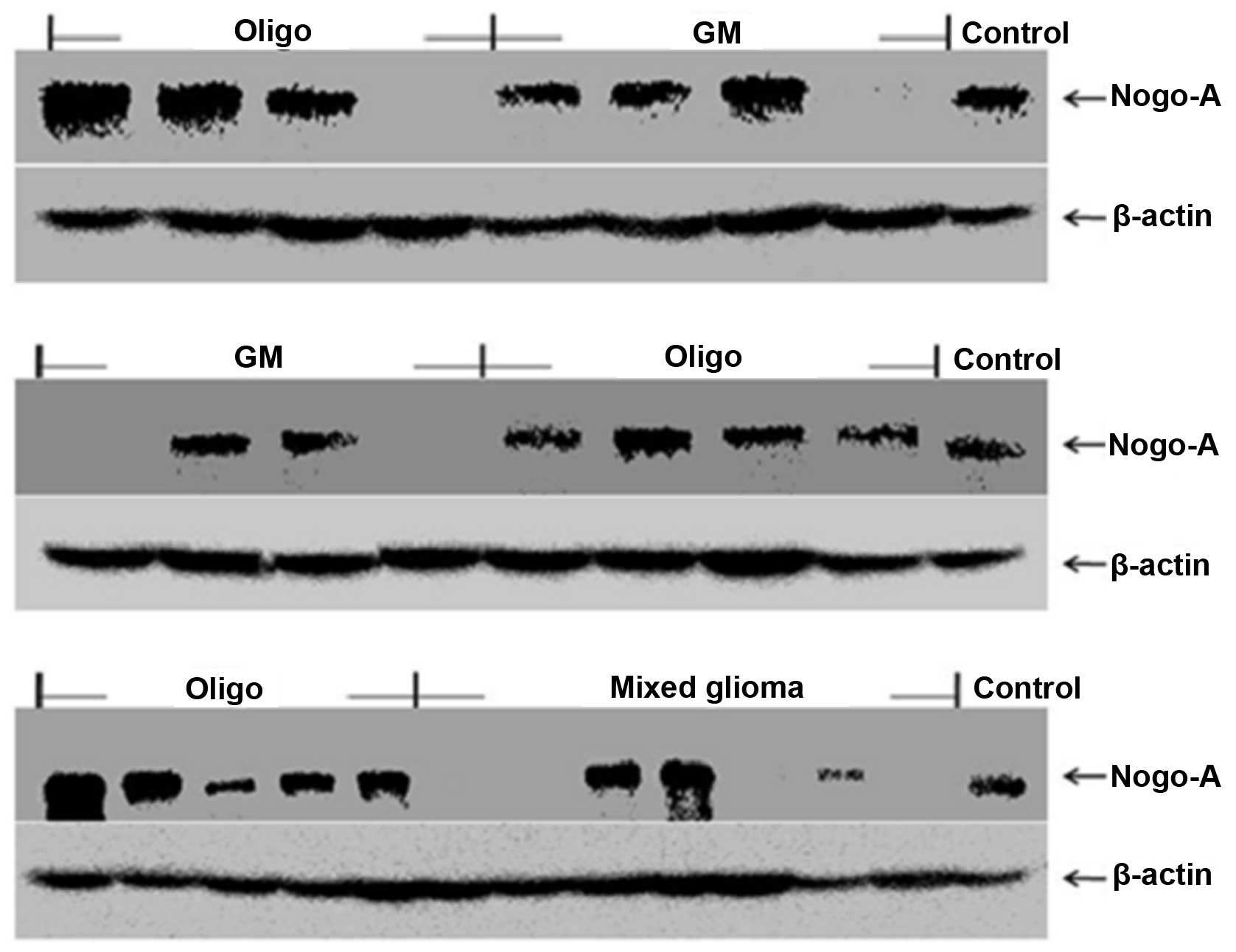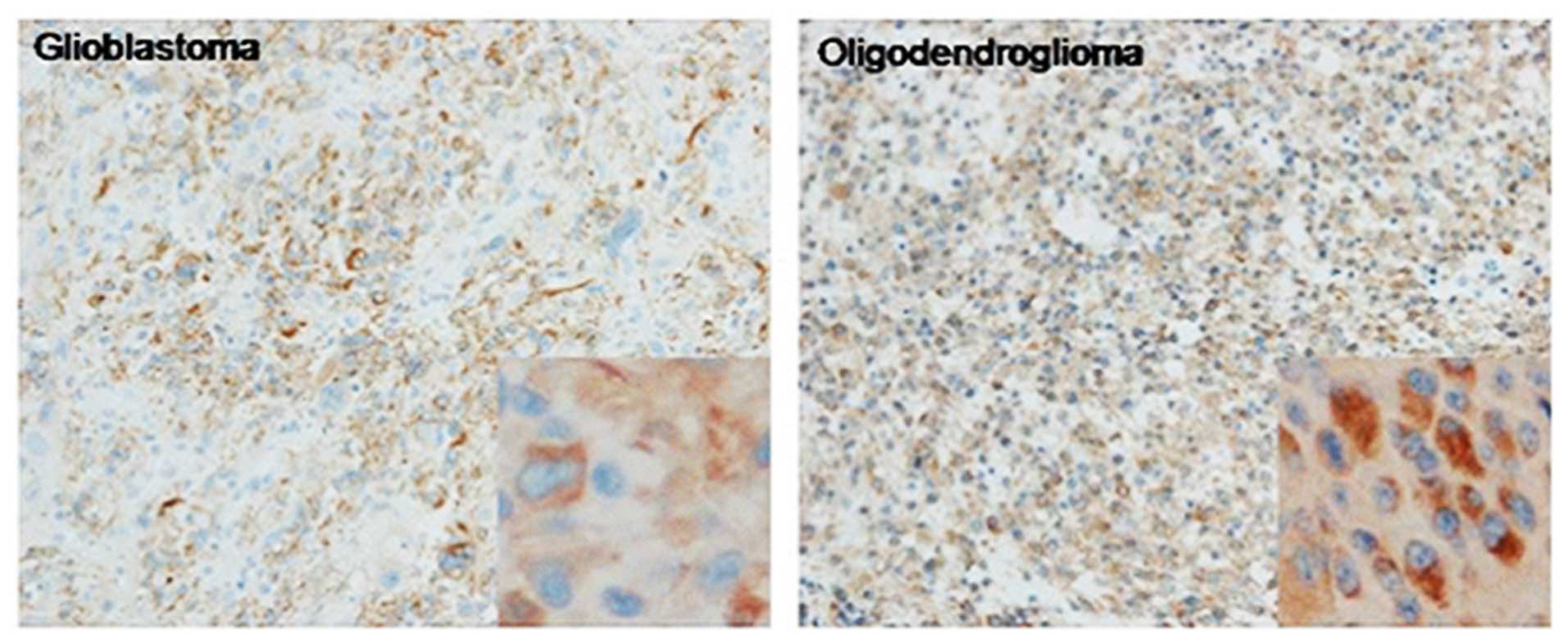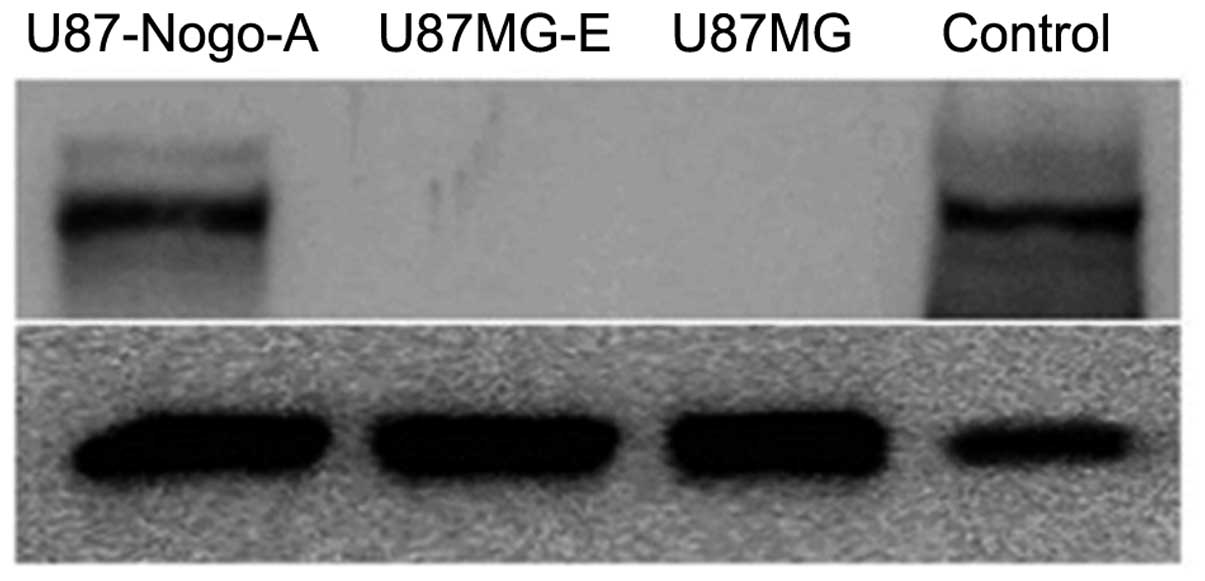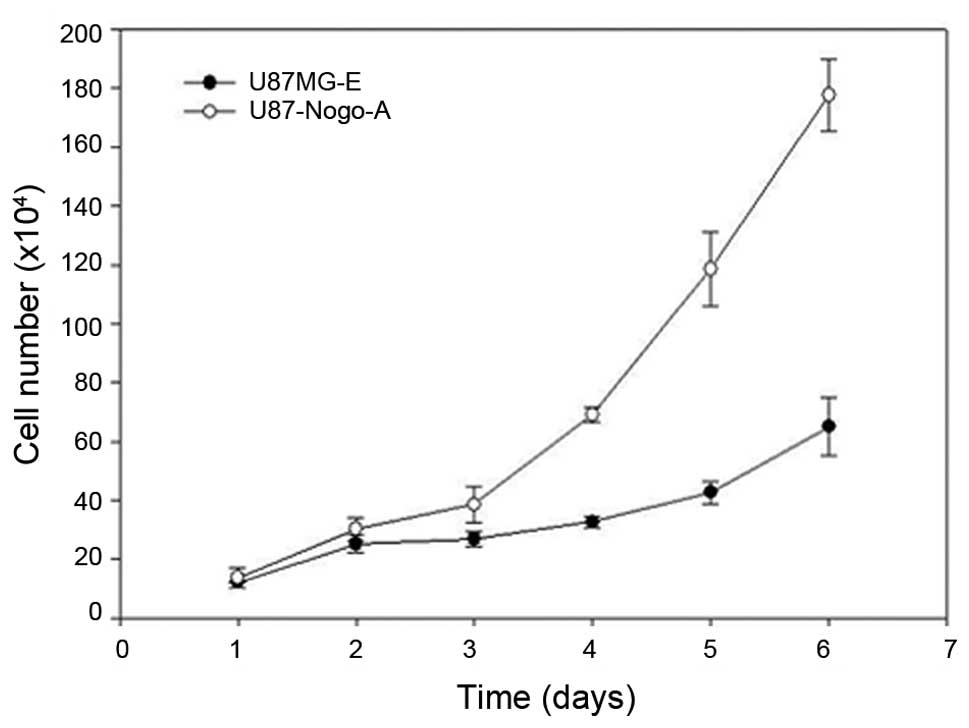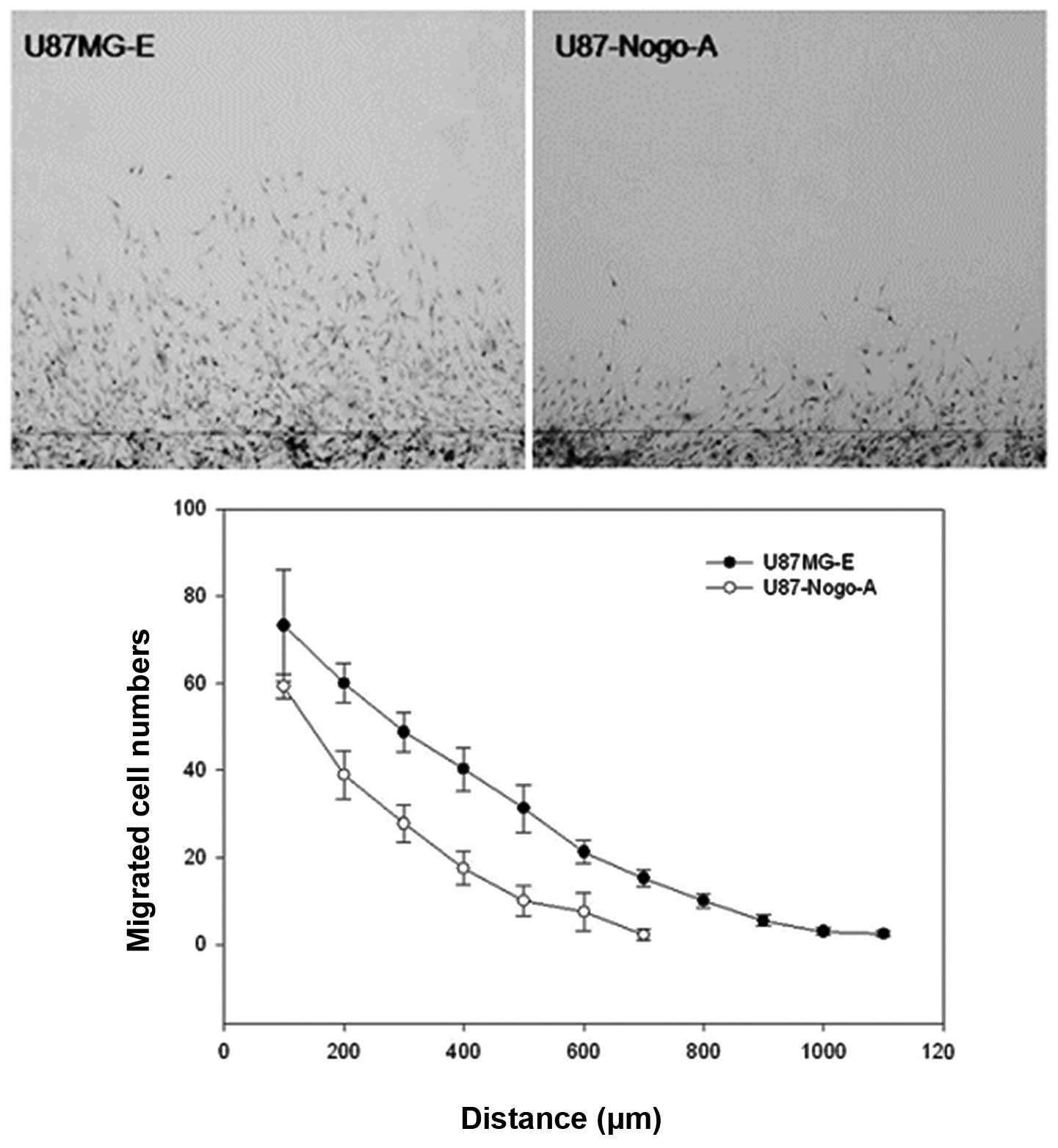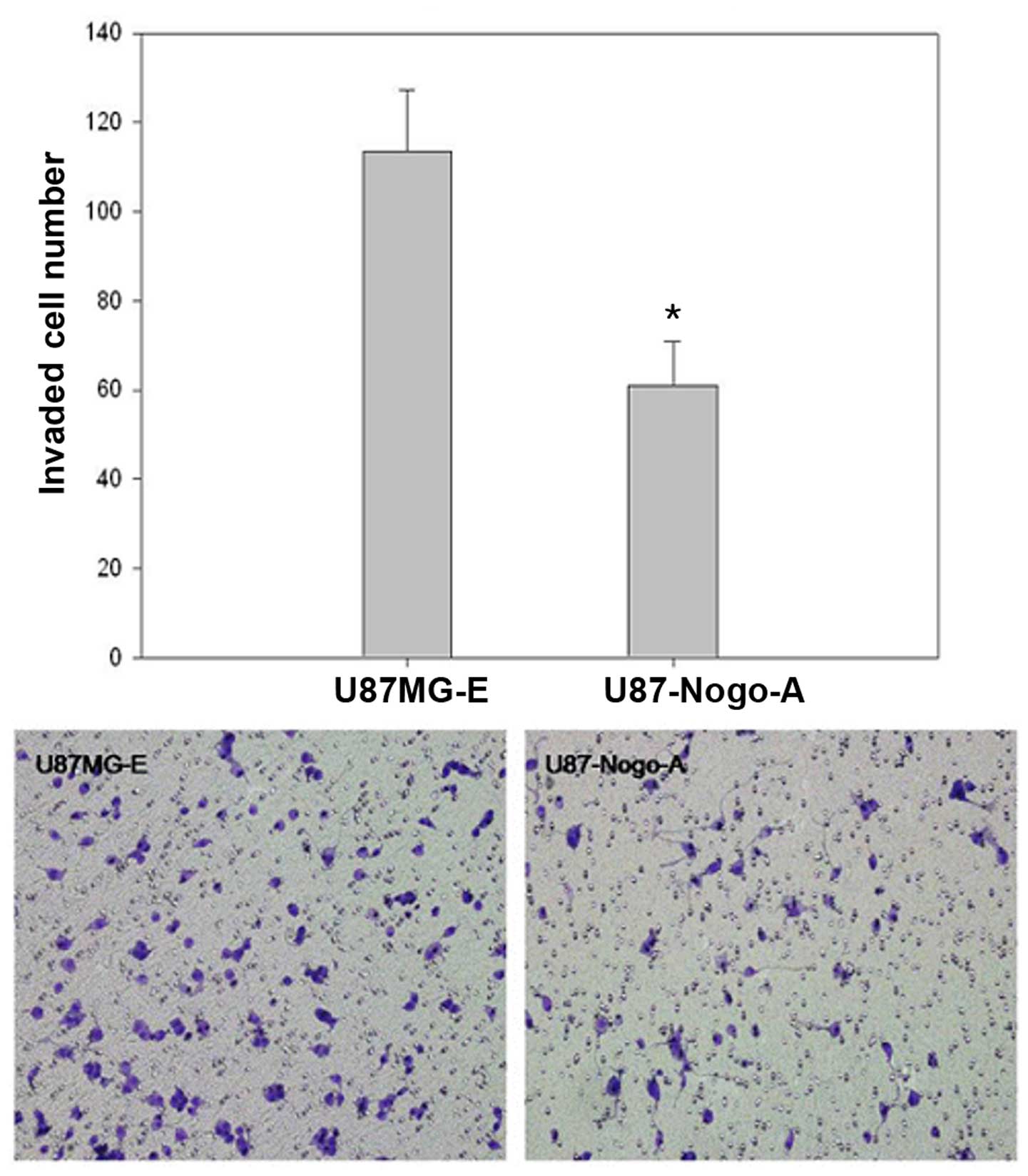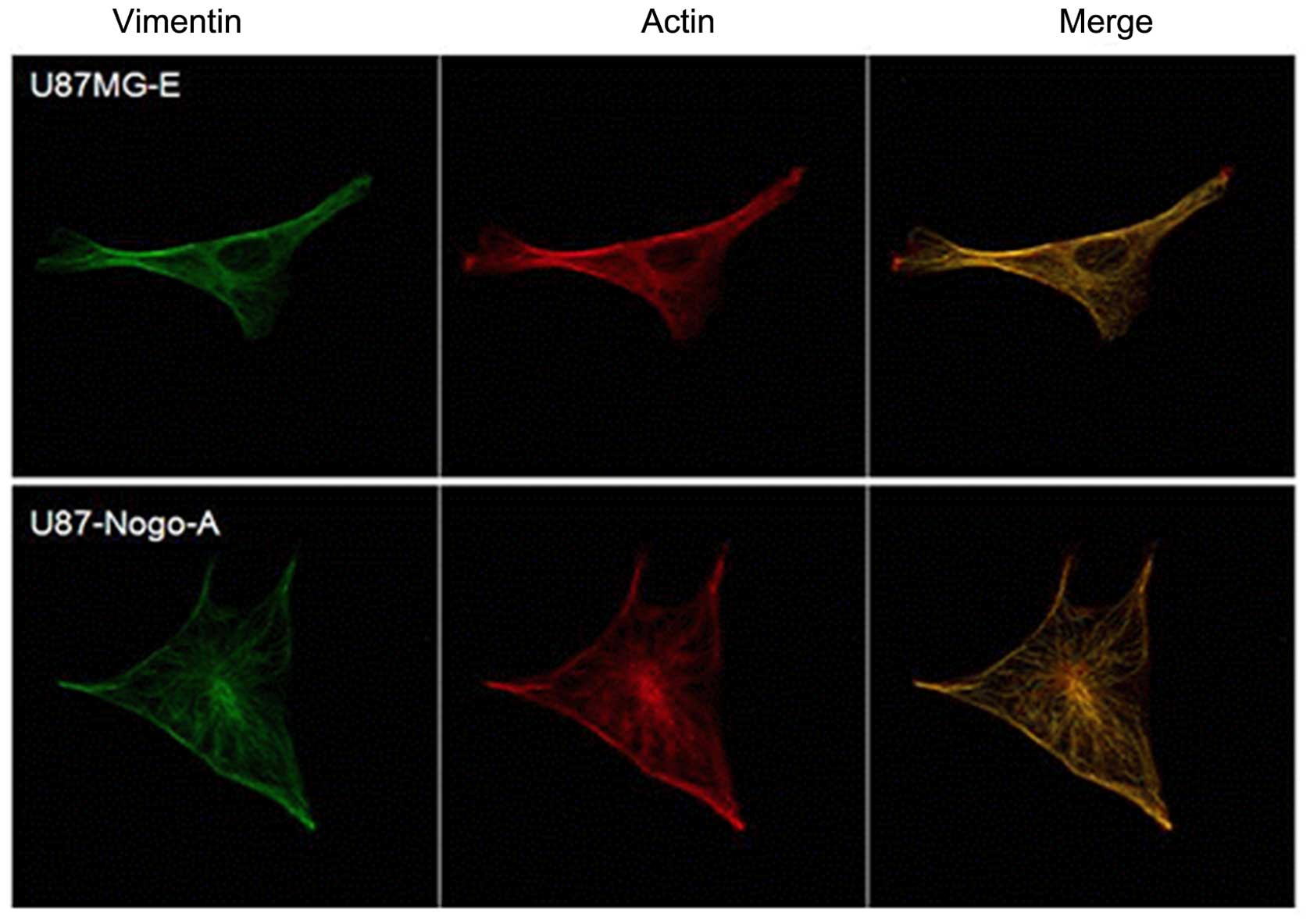|
1
|
Maher EA, Furnari FB, Bachoo RM, Rowitch
DH, Louis DN, Cavenee WK and DePinho RA: Malignant glioma: Genetics
and biology of a grave matter. Genes Dev. 15:1311–1333. 2001.
View Article : Google Scholar : PubMed/NCBI
|
|
2
|
Guo L, Qiu Y, Ge J and Zhou D:
Glioblastoma multiforme with subcutaneous metastases, case report
and literature review. J Korean Neurosurg Soc. 52:484–487. 2012.
View Article : Google Scholar
|
|
3
|
Oertle T, Klinger M, Stuermer CA and
Schwab ME: A reticular rhapsody: Phylogenic evolution and
nomenclature of the RTN/Nogo gene family. FASEB J. 17:1238–1247.
2003. View Article : Google Scholar : PubMed/NCBI
|
|
4
|
GrandPré T, Li S and Strittmatter SM:
Nogo-66 receptor antagonist peptide promotes axonal regeneration.
Nature. 417:547–551. 2002. View
Article : Google Scholar : PubMed/NCBI
|
|
5
|
Huber AB, Weinmann O, Brösamle C, Oertle T
and Schwab ME: Patterns of Nogo mRNA and protein expression in the
developing and adult rat and after CNS lesions. J Neurosci.
22:3553–3567. 2002.PubMed/NCBI
|
|
6
|
Hunt D, Coffin RS, Prinjha RK, Campbell G
and Anderson PN: Nogo-A expression in the intact and injured
nervous system. Mol Cell Neurosci. 24:1083–1102. 2003. View Article : Google Scholar : PubMed/NCBI
|
|
7
|
Wang X, Chun SJ, Treloar H, Vartanian T,
Greer CA and Strittmatter SM: Localization of Nogo-A and Nogo-66
receptor proteins at sites of axon-myelin and synaptic contact. J
Neurosci. 22:5505–5515. 2002.PubMed/NCBI
|
|
8
|
Josephson A, Widenfalk J, Widmer HW, Olson
L and Spenger C: NOGO mRNA expression in adult and fetal human and
rat nervous tissue and in weight drop injury. Exp Neurol.
169:319–328. 2001. View Article : Google Scholar : PubMed/NCBI
|
|
9
|
Niederöst B, Oertle T, Fritsche J,
McKinney RA and Bandtlow CE: Nogo-A and myelin-associated
glycoprotein mediate neurite growth inhibition by antagonistic
regulation of RhoA and Rac1. J Neurosci. 22:10368–10376.
2002.PubMed/NCBI
|
|
10
|
Boureux A, Vignal E, Faure S and Fort P:
Evolution of the Rho family of ras-like GTPases in eukaryotes. Mol
Biol Evol. 24:203–216. 2007. View Article : Google Scholar
|
|
11
|
Kuhlmann T, Gutenberg A, Schulten HJ,
Paulus W, Rohde V and Bruck W: Nogo-a expression in glial CNS
tumors: A tool to differentiate between oligodendrogliomas and
other gliomas? Am J Surg Pathol. 32:1444–1453. 2008. View Article : Google Scholar : PubMed/NCBI
|
|
12
|
Xiong NX, Zhao HY, Zhang FC and He ZQ:
Negative correlation of Nogo-A with the malignancy of
oligodendroglial tumor. Neurosci Bull. 23:41–45. 2007. View Article : Google Scholar : PubMed/NCBI
|
|
13
|
Jung TY, Jung S, Lee KH, Cao VT, Jin SG,
Moon KS, Kim IY, Kang SS, Kim HS and Lee MC: Nogo-A expression in
oligodendroglial tumors. Neuropathology. 31:11–19. 2011. View Article : Google Scholar
|
|
14
|
Schwab ME: Myelin-associated inhibitors of
neurite growth and regeneration in the CNS. Trends Neurosci.
13:452–456. 1990. View Article : Google Scholar : PubMed/NCBI
|
|
15
|
Teng FY and Tang BL: No go for brain
tumors? J Mol Neurosci. 25:1–6. 2005. View Article : Google Scholar : PubMed/NCBI
|
|
16
|
Walker JM: The bicinchoninic acid (BCA)
assay for protein quantitation. Methods Mol Biol. 32:5–8.
1994.PubMed/NCBI
|
|
17
|
Giese A and Westphal M: Glioma invasion in
the central nervous system. Neurosurgery. 39:235–252. 1996.
View Article : Google Scholar : PubMed/NCBI
|
|
18
|
van de Velde HJ, Roebroek AJ, Senden NH,
Ramaekers FC and Van de Ven WJ: NSP-encoded reticulons,
neuroendocrine proteins of a novel gene family associated with
membranes of the endoplasmic reticulum. J Cell Sci. 107:2403–2416.
1994.PubMed/NCBI
|
|
19
|
Buss A, Sellhaus B, Wolmsley A, Noth J,
Schwab ME and Brook GA: Expression pattern of NOGO-A protein in the
human nervous system. Acta Neuropathol. 110:113–119. 2005.
View Article : Google Scholar
|
|
20
|
Mingorance-Le Meur A, Zheng B, Soriano E
and del Río JA: Involvement of the myelin-associated inhibitor
Nogo-A in early cortical development and neuronal maturation. Cereb
Cortex. 17:2375–2386. 2007. View Article : Google Scholar
|
|
21
|
Su Z, Cao L, Zhu Y, Liu X, Huang Z, Huang
A and He C: Nogo enhances the adhesion of olfactory ensheathing
cells and inhibits their migration. J Cell Sci. 120:1877–1887.
2007. View Article : Google Scholar : PubMed/NCBI
|
|
22
|
Ridley AJ, Schwartz MA, Burridge K, Firtel
RA, Ginsberg MH, Borisy G, Parsons JT and Horwitz AR: Cell
migration: Integrating signals from front to back. Science.
302:1704–1709. 2003. View Article : Google Scholar : PubMed/NCBI
|
|
23
|
Pollard TD and Borisy GG: Cellular
motility driven by assembly and disassembly of actin filaments.
Cell. 112:453–465. 2003. View Article : Google Scholar : PubMed/NCBI
|
|
24
|
Raftopoulou M and Hall A: Cell migration:
Rho GTPases lead the way. Dev Biol. 265:23–32. 2004. View Article : Google Scholar
|
|
25
|
Yamazaki D, Kurisu S and Takenawa T:
Regulation of cancer cell motility through actin reorganization.
Cancer Sci. 96:379–386. 2005. View Article : Google Scholar : PubMed/NCBI
|
|
26
|
Glotzer M: The molecular requirements for
cytokinesis. Science. 307:1735–1739. 2005. View Article : Google Scholar : PubMed/NCBI
|
|
27
|
Ridley AJ: Rho GTPases and cell migration.
J Cell Sci. 114:2713–2722. 2001.PubMed/NCBI
|
|
28
|
Chrzanowska-Wodnicka M and Burridge K:
Rho-stimulated contractility drives the formation of stress fibers
and focal adhesions. J Cell Biol. 133:1403–1415. 1996. View Article : Google Scholar : PubMed/NCBI
|
|
29
|
Fritz G, Just I and Kaina B: Rho GTPases
are over-expressed in human tumors. Int J Cancer. 81:682–687. 1999.
View Article : Google Scholar : PubMed/NCBI
|
|
30
|
Horiuchi A, Imai T, Wang C, Ohira S, Feng
Y, Nikaido T and Konishi I: Up-regulation of small GTPases, RhoA
and RhoC, is associated with tumor progression in ovarian
carcinoma. Lab Invest. 83:861–870. 2003. View Article : Google Scholar : PubMed/NCBI
|
|
31
|
Kamai T, Arai K, Tsujii T, Honda M and
Yoshida K: Overexpression of RhoA mRNA is associated with advanced
stage in testicular germ cell tumour. BJU Int. 87:227–231. 2001.
View Article : Google Scholar : PubMed/NCBI
|
|
32
|
Kamai T, Tsujii T, Arai K, Takagi K, Asami
H, Ito Y and Oshima H: Significant association of Rho/ROCK pathway
with invasion and metastasis of bladder cancer. Clin Cancer Res.
9:2632–2641. 2003.PubMed/NCBI
|
|
33
|
Liu N, Bi F, Pan Y, Sun L, Xue Y, Shi Y,
Yao X, Zheng Y and Fan D: Reversal of the malignant phenotype of
gastric cancer cells by inhibition of RhoA expression and activity.
Clin Cancer Res. 10:6239–6247. 2004. View Article : Google Scholar : PubMed/NCBI
|
|
34
|
Yan B, Chour HH, Peh BK, Lim C and
Salto-Tellez M: RhoA protein expression correlates positively with
degree of malignancy in astrocytomas. Neurosci Lett. 407:124–126.
2006. View Article : Google Scholar : PubMed/NCBI
|
|
35
|
Bernard O: Lim kinases, regulators of
actin dynamics. Int J Biochem Cell Biol. 39:1071–1076. 2007.
View Article : Google Scholar
|
|
36
|
Endo M, Ohashi K, Sasaki Y, Goshima Y,
Niwa R, Uemura T and Mizuno K: Control of growth cone motility and
morphology by LIM kinase and Slingshot via phosphorylation and
dephosphorylation of cofilin. J Neurosci. 23:2527–2537.
2003.PubMed/NCBI
|
|
37
|
Endo M, Ohashi K and Mizuno K: LIM kinase
and slingshot are critical for neurite extension. J Biol Chem.
282:13692–13702. 2007. View Article : Google Scholar : PubMed/NCBI
|
|
38
|
Ridley AJ: Rho GTPases and actin dynamics
in membrane protrusions and vesicle trafficking. Trends Cell Biol.
16:522–529. 2006. View Article : Google Scholar : PubMed/NCBI
|















